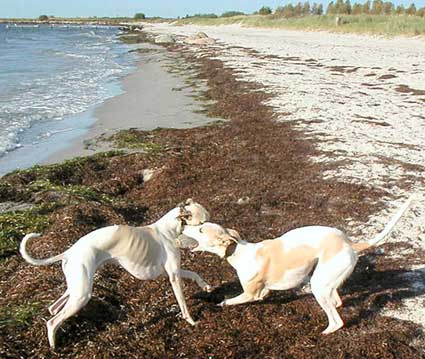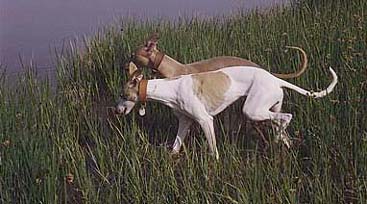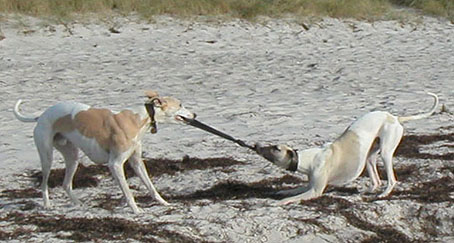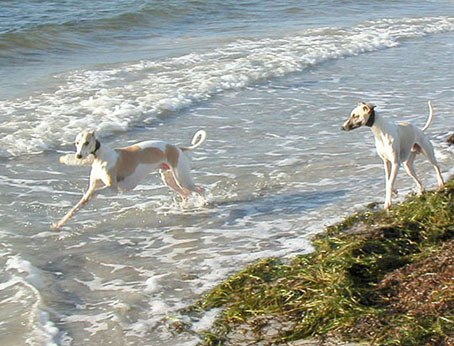Sighthounds on the loose! |
|
(I call all dogs "he" as all mine are males!) |
| Sighthounds just love to run free - of course! They are quick to learn and only really want to please their owner. They are trustworthy and loyal and often stay near you when you walk with them on the loose, but one must constantly be aware that they can in seconds, be miles away, if they see something to chase after - and if there is something to see - then they will see it!!! Here is how you treat them and train them for maximum obedience. |
The first thing you must have uppermost in your mind: The point to keep in mind is, that the moment when the dog has come to your feet, he has done the right thing! He's done what you wanted! His behavior is at that moment in time is 100% correct. |
 Photo: An Eikica show Greyhound posing beside a Danish lake in winter. Training: From the first moment you bring your new dog into your home, have some dry puppy food always at the ready in your pocket. (I say puppy food, as the pieces are very small - do NOT use something unhealthy like chocolate, which is poisonous for dogs! Rather use a brand of dog food that you reserve only for treats.) Call his name in sweet (but commanding) tones and reward with praise and a single piece of the puppy food every time he comes. Do this often - but not so often he gets bored with it! This is the first important step. Takes just 5 minutes to learn!!! The place where you will walk the dog The next step is to choose with care the area where you will take the daily walk. There must not be busy roads too near or too many wild animals. Open areas are best for Sighthounds as they CAN crash into trees - they look back to see what you're doing or if other dogs are chasing behind and at high speed, suddenly - wham! Take the walk five or six times or more (if it's an older dog who's new to you, then MANY times over 2-3 weeks), whilst keeping the dog on the leash. (Once a day, not 5-6 times a day!) Let him examine the route the whole time. The idea is that he learn the route thoroughly before getting his freedom. By learning the area, he won't get lost or panic if suddenly he runs off the beaten track. It's best to always take the same route each time. Always walk at the same time every day. Wild animals learn quickly and will scram out of it fast, prior to your coming each day - if they have a chance to get to know you! Fix something on to the dog's collars that rings or tinkles and the sound of this will act as a warning to all the wild creatures. A hare only has to be chased after once and it will make quite sure it doesn't happen again if it can recognize the same collar bells ringing! You can whistle, sing and speak unnaturally loudly to the dogs or stamp or clap occasionally - anything that will scare wild animals far away! Believe me, the wild animals soon learn to keep away from your dogs! I'm of course assuming that you, as I do, have the dogs as pets living in your house together with you. For those of you who have their dogs shut away somewhere the most of the time or permanently, this close bonding between owner and dog is impossible and you may never be able to trust your dog in the same way when, if ever, it runs free. It will no doubt ignore you and make full use of the freedom and refuse to be caught. I know I would do the same, if I was a dog who never went on regular walks! WARNING: If it's an older dog you've taken over from someone else, who is not used to having his freedom, take an extra long time getting him used to the area where you walk whilst keeping him on the leash, and be sure he has become devoted and faithful to you and comes enthusiastically every time he is called. I'd take several weeks to be on the safe side. I always train my dogs to come to a whistle as well. A soundless whistle carries further, especially for men whose voice is usually isn't as effective as a womans! A whistle can also be used by others, should they walk the dog for you one day - so he's not just used to just one or two particular human voices. And it's more discreet than plain standing hollering, should he disappear and other people are around! Note: Never underestimate how different you may look to a dog when he sees you from a great distance - and maybe for the first time! Remember that moving objects are easier to spot than stationary, so don't just stand there calling, run to and fro! You can also wave a large white handkerchief. I always do. He will also tend to run to look for you where he last saw you - so don't wander too far away. |
Don't be deceived by a sighthound. If you get a puppy and start walking short distances every day - this is great and you'll have few problems. But I have heard sad stories of several "beginner" owners of older re-homed or rescued sighthounds who, despite warnings from the breeder, let their newly acquired dog run free straight away - without any of the precautions I mention above.
Sighthounds are easily bored and therefore can appear very docile, quiet and sweet, often moving slowly most of the walk. This is deceptive. A new owner can believe that all is well and go off on a walk in the countryside with the dog off leash. But the docile sighthound can, faster than anyone would dream of, turn suddenly into a bullet shot out of a gun and race off at such a speed that it can in seconds be up to a mile away and perhaps out of earshot! If your dog has run off and you have waited a hour calling an whistling, then what do you do? Well, never stop looking and calling and if possible get hold of someone he knows, who can help. Get the police, local dog rescue involved. Put up notices in schools, on trees, notice boards in shopping malls etc. He's out there somewhere dying for you to rescue him. |
BACK TO CHOOSER You are welcome to write to: janetfm@sighthound.net - I try to always answer promptly! |


